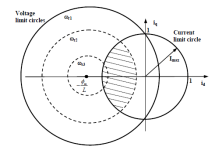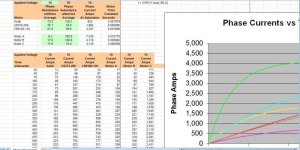Ok, so in the interest of bringing facts to the table I went on another search for a reference to try and prove this one way or the other. I found this:
http://power.eecs.utk.edu/pubs/Copy of pinto_dissertation.pdf
It's a PhD dissertation, so it's a little dense for those without an engineering background, but I think it explains well. Specifically, it requires for you to have some knowledge of vector control, although it does explain somewhat. The most useful stuff is in Ch4. I'll try to summarize.
The operating range of a motor is defined by the intersection of two circles, one for the voltage limit and one for the current limit. For our purposes, it's simpler if we assume that the motor and inverter have the same current limit. It looks like this:

At low speeds, voltage doesn't matter and you can produce any desired torque up to the current limit. This is called the constant-torque range. In terms of vector control, Iq is controlled and Id is kept to zero. Iq is the current aligned with the EMF, the component that produces useful torque. Id produces no torque, but can oppose (or augment) the magnetic flux. So, in this region, the current is kept aligned with EMF,all the current produces useful torque, and we can produce any desired Iq up to Imax. Note that keeping Id zero does require timing advance.
"Base speed" is the limit of the constant-torque range. In terms we're more familiar with, this is the max-power point, or roughly half of the free-wheel speed of the motor. Above this speed, we can no longer produce maximum torque, but the torque*speed product remains constant so this is the constant-power range (see wr_2 in the picture above). If we keep Id zero, the maximum Iq we can generate rapidly reduces until we can no longer produce any useful torque. Instead, we apply a negative Id, which is called field-weakening (because it opposes the permanent magnet flux). By choosing the right value for Id, we can place ourselves at the intersection of the voltage and current circles, which maximizes the possible torque. The required Id gets larger as the speed increases, which causes Iq to decrease to stay within the limit Imax = sqrt(Id^2 + Iq^2). Basically, this is like adding
more timing advance. If eventually Id = Imax, then Iq will be zero and we can no longer produce any torque. This is the limit of the constant-power range.
Now comes the important part, which I'll quote directly from the paper: "If the inductance is large enough, the constant power speed range can be infinite." In the picture above, the center of the voltage circle is given by the ratio of the PM flux density to the inductance. If the inductance is large enough, this point will be inside the current limit circle, which means that we will always be able to produce some useful torque even at very high speeds. If the center is outside the current circle, then there will always be a finite speed at which we can no longer make Iq > 0, thus above this point we can't produce any torque.
So, a higher-inductance motor will actually be able to produce torque at a higher speed than a comparable low-inductance motor. I have to admit I actually didn't expect that result, but after reading I understand why and how. I will note that this doesn't say anything about inductance vs. power or inductance vs. power density, so I'll leave that part of the discussion be. The paper also does note that, in general, a low-inductance motor will have a larger CT region and a high-inductance motor will have a larger CP region. The specific application here is to a sinusoidal-EMF motor (PMSM), but the application is similar for a trapezoidal motor and square-wave commutation.



